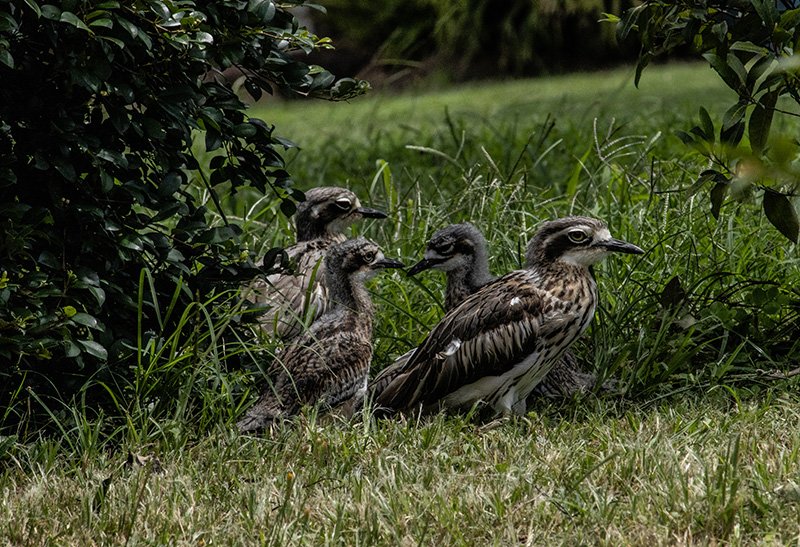Is it okay to feed wild birds?
A bush stone-curlew family — wild birds in a Coochiemudlo Island neighbourhood.
by Angela Hoskins
Feeding wild birds is a world-wide, nature-based pastime, a practice that can connect us to other species we share the world with.
However, if birds are regularly fed the wrong food there can be severe health consquences including brittle bones and soft beaks — especially when they are young. Experts warn that our relationships with wild creatures can be wonderful for us but bad for the birds.
Info in this article:
Perspective from a behavourial ecologist
BirdLife Australia advice about what to feed wild birds
Environment and Education Unit, Redlands City Council advice about what to feed wild birds
Griffith University professor of ecology Darryl Jones has said that years ago, if you wanted to know anything about feeding birds, you’d get a barrage of ‘you shouldn’t feed the birds at all’.
Jones, an avid researcher of the interaction between people and wildlife in cities, began feeding birds. He believes that feeding wild birds can be calming yet exciting, healing, connecting and illuminating. Having birds visit us for food offers us brief encounters with truly wild creatures — a chance to connect with nature. Others feed birds because they sincerely want to help nature, to compensate for human’s negative impact to the environment.
However, most people don’t know if they’re feeding the birds properly or not, and information has been lacking because of the taboo. “They’re feeding terrible things [to birds], and causing all sorts of problems but they don’t realise that”, Jones said.
(Paraphrased from ‘Australians are always told ‘don’t feed the birds’ – if you really must, here’s how to do it properly’, an article by Debbie Lustig in Guardian Australia, Sept. 2023)
Advice from BirdLife Australia
Bad foods for birds
Bread and crackers: These highly processed foods contain a lot of salt and offer little nutritional value to birds. Bread can contain mould which can cause a potentially respiratory infection in birds.
Mince: Mince does not contain the calcuim and other elements required to maintain a bird’s healthy bones and beaks: catching insects is impossible if beaks are weak, and getting about is difficult if their legs are weak. Meats that are high in fats are also not good for birds to metabolise. Plus, these meats can stick to a bird’s beak forming bad bacteria.
Honey and sugar: Standard sugars that humans have in their kitchens are not good for birds. They lack the complex balance that nectar from flowers or some fruits provide for birds in the wild.
Good foods for birds
Earthworms, mealworms and insects: Dig them out of your own garden, catch grasshoppers, or buy crickets and mealworms (either live or freeze-dried) from pet stores.
Insectivore, a calcium-rich commercial mix bought from pet shops is recommended for adding important nutrients to bird food.
Bird nectar mix: Pet stores offer specially formulated, nutritionally balanced dry or wet nectar mixes that mimic the natural diets of nectar-eating birds like honeyeaters and lorikeets.
Most Australian birds need a varied and balanced diet of insects and nectar, seeds or fruit to stay healthy. Best-practice tips for feeding wild birds that include:
Think of feeding wild birds as a treat — for us and them — that we enjoy no more than once a week
Choose good foods for birds to ensure that their diet stays natural and balanced
Plant a bird-friendly garden with plenty of nectar-rich native flowers that our wild birds love.
Advice from the Environment and Education Unit, Redland City Council
As a rule, it is not a good idea to feed any wild birds, however, we all know that this does and will occur. Getting the information out to residents and visitors to the island that a human diet it is not good for birds is paramount, especially for visitors to the island. If you ‘must’ feed birds, these are the details about what to feed and what not to feed.
Don’t feed birds mince
The fat content is far too high, and it does not contain the nutrients required.
(If you insist on feeding mince because it is all you have, only do so if the mince is the highest-grade, without fat, and it must insectivore mixed in with it.)
Mix Insectivore with the food
Insectivore is a powdered nutritional supplement for birds. It’s very important to follow the directions on the pack and add just the right amount of Insectivore. Too little and it won’t work; too much and it will harm the bird.
Meat that is a better option
Ox-heart, liver, kidney, heart, brain. These are cheap and available at supermarkets and are all rich in minerals. They can be cut into small pieces and frozen.
Best options for feeding wild birds
Start up a mealworm farm or cricket farm. Alternatively, you can purchase meal worms and crickets from pet stores.
Never feed birds more than once a day, and never much — this is very important. If you feed them too regularly, the birds can starve if you go away — they could remain waiting at your place for their feed without foraging for themselves.
In summary …
If the wrong foods are fed to wild birds, their wellbeing is compromised because they are not getting the nutrients that are important to maintain their health. With too much human intervention with feeding birds, they can also lose their appetite to forage for food in the natural environment.
Humans enjoy communing with nature by feeding wild birds. Wild birds can also benefit from supplementary feeding — as long as the food we offer them closely matches, or is identical to, what food they eat naturally and is therefore best for their wellbeing.
Research from:
‘Covid-related surge in global wild bird feeding’, PLoS ONE, Griffith University
‘Australians are always told ‘don’t feed the birds’ – if you really must, here’s how to do it properly’ Guardian Australia

